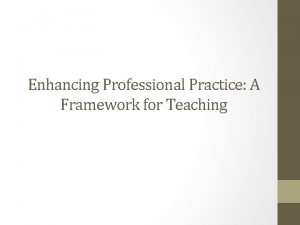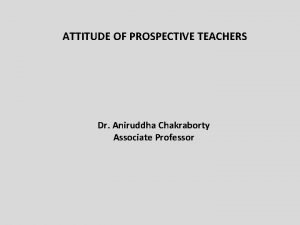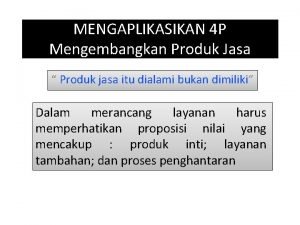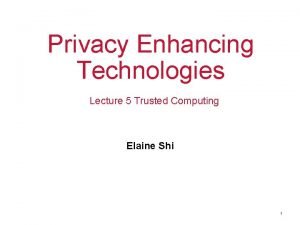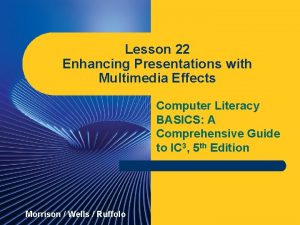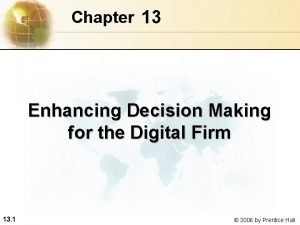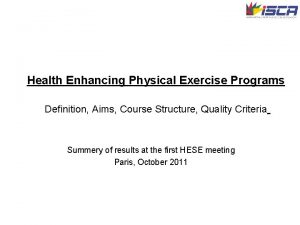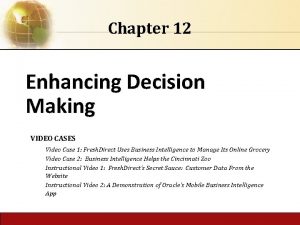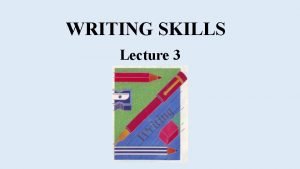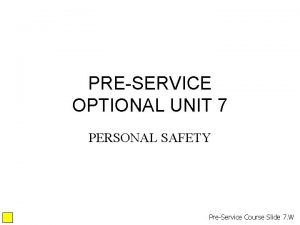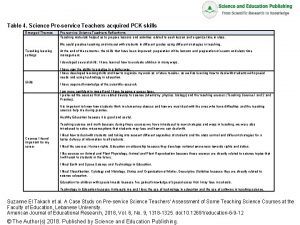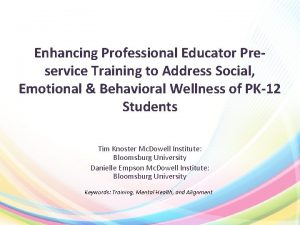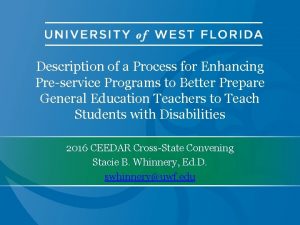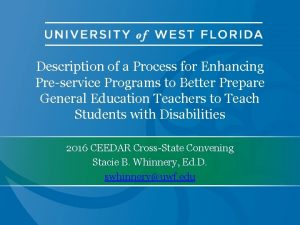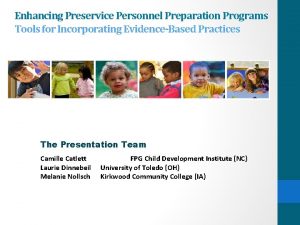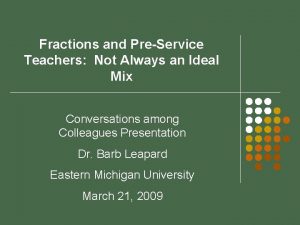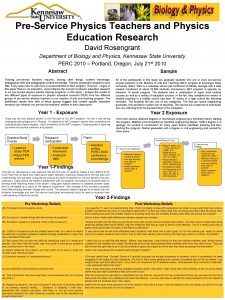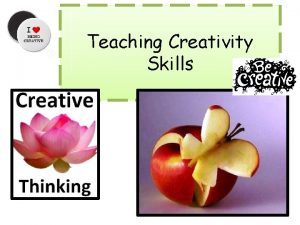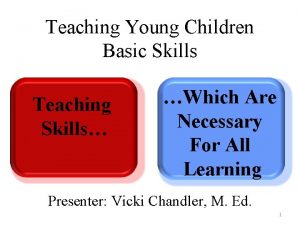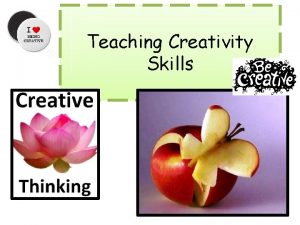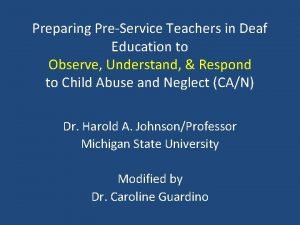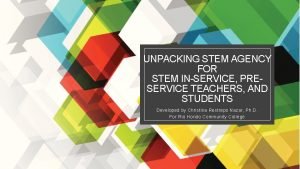Videorecording Enhancing preservice teachers selfreflection and teaching skills






















- Slides: 22

Video-recording: Enhancing pre-service teachers’ self-reflection and teaching skills Phan Quynh Nhu & Ton Nu Thanh Thuy College of Foreign Languages Hue University 1

Outline and Aims Outline 1. Background to the study 2. Methodology 3. Findings and Discussion 4. Conclusions and Implications Aims: Seeking answers to the questions: • Could video-recording be used to record the pre-service teachers’ microteachings? • To what extent could the technique enhance their teaching skills and self-reflection? 2

Background to the study Slagoski (2007) Microteaching: a procedure through which pre-service teachers - practice their instructional methods with peers, - build confidence, receive support and get feedback from trainer and peers. Kong, Shroff & Hung (2009) : Self refection Pre-service teachers should seriously consider and thoughtfully judge their own prior experience => self-reflection 3

Two stages of self-reflection In action: T makes immediate decisions based on observation in actions. • On action: T reflects back on the actions and refines upon the actions in the following classes; to identify strengths and weaknesses. • 4

Why Video recording ? English teachers should be autonomous learners in their life-long career. => Video recording provides: • a reliable and durable means • a tool for reflection • an objective, permanent source • a tool for observing various aspects of classroom practice • a tool for reflecting on nonverbal aspects of teaching 5

Kong, Shroff and Hung (2009): web-enabled video system to encourage pre-service teachers to reflect on their teaching performance - to assist the teachers to self-produce a real time record of teaching work - to manage the record without being constrained by time and location. - 6

However, … Wright (2008): several logistical and organizational challenges: • barriers to the use of video supported reflection. videos: too cluttered for teachers (especially novices) to focus on particulars. • 7

Methodology Participants - 35 pre-service EFL teachers (third year students) - two 7 -10 minute microteachings per teacher Instruments • Video-recording: a personal camera, videos uploaded onto a forum for class members (http: //phuongphap 1 k 5. hnsv. com/) • Reflection forms: filled after viewing videos 8

Methodology • Questionnaire: Reliable 25 close and open-ended questions - 28 copies collected from pre-service teachers - reliability coefficient of 25 scale items: = 0. 775 Data analysis - by qualitative and quantitative methods - using the Statistics Package for Social Studies version 19. 0. - 9

Findings - Attitudes 1. Attitudes towards video-recording the teachers’ microteachings a. Table 1: Viewing recordings for reflections Num of viewings for N Reflections 1 Valid = 32 Mean Median Mode SD Min Max 3. 42 3 3 1. 43 0 7 Missing= 0 Reflections 2 Valid: 28 3. 21 Missing: 4 3 2 1. 17 2 6 b. Viewing peers’ lessons: 96. 4% (Mode: 10, Min: 3; Max: 30) 10

Attitudes - 78. 6% had difficulties in viewing own or peers’ lessons Table 2: Difficulties upon viewing Difficulties Low-quality videos Much time consumption No personal computer Trouble in video access Technical troubles Limited internet access Frequency 77. 3% 36. 4% 17. 5% 13. 6% 9, 1% 11

Attitudes - 78. 6% had difficulties in viewing own or peers’ lessons Table 3: How convenient their viewings were Viewing 1. directly online 2. on personal totally disagree neutral disagree totally agree 0. 0 35. 7 14. 3 42. 9 7. 1 3. 6 14. 3 21. 4 25. 0 35. 7 3. 6 46. 4 17. 9 32. 1 0. 0 computer 3. clearly videos 12

Attitudes Table 4: Specific focuses upon viewing Focus on N=28 (valid=28, missing=0) 1. instructions 2. steps of carrying out activities 3. language of instruction 4. use of teaching aids 5. error correction 6. use of board 7. interactions with students 8. involving students 9. posture in class totally disagree neutral disagree totally agree 0 0 3. 6 57. 1 50. 0 39. 3 42. 9 0. 0 0. 0 3. 6 14. 3 0. 0 10. 7 46. 4 67. 9 60. 7 57. 1 53. 6 28. 6 25. 0 42. 9 35. 7 0. 0 10. 7 0. 0 53. 6 32. 1 35. 7 67. 9 13

Effectiveness Table 5: Improvement after viewing After viewing, they could totally disagree neutral agree disagree improve 0 0 7. 1 78. 6 1. instructions 2. steps of carrying out activities 3. language of instruction 4. use of teaching aids 5. error correction 6. use of board 7. interactions with ss 8. involving students 9. posture in class totally agree 14. 3 0. 0 7. 1 3. 6 60. 7 28. 6 0. 0 10. 7 53. 6 35. 7 0. 0 3. 6 17. 9 53. 6 25. 0 0. 0 53. 6 46. 4 0. 0 17. 9 42. 9 39. 3 0. 0 7. 1 10. 7 64. 3 17. 9 0. 0 3. 6 46. 4 50. 0 14

Effectiveness Table 6: Overall improvement after viewing The pre-service students totally disagree neutral were disagree totally agree 1. better at teaching skills. 2. able to self-evaluate their microteachings. 0 0. 0 14. 3 21. 4 64. 3 0. 0 21. 4 60. 7 17. 9 15

Possibility of using video-recordings - Figure 1: Comparison of variables’ means 16

Conclusion The pre-service teachers: - were aware of and highly appreciated videorecording, - experienced some difficulties: low quality of videos, time consumption. àmore use of video-recording in other ELT methodology courses. 17

Conclusion The pre-service teachers: - improved skills of classroom management and sub-skills of teaching English, - believed their overall teaching performance would be improved, - were able to recognize their strengths and weakness, - did not improve much between 1 st and 2 nd reflections (short interval + limited number of the reflections). 18

Implications Teacher trainers should - realize the significance of video-recording, - widely apply video-recording, - integrate technology into ELT syllabuses’, - be more competent in applying advanced technology in their training. 19

Implications Pre-service teachers should: - take advantage of video-recording to facilitate their self-directed learning, - be aware of the significance of self-reflecting in their professional progress. The leading board of HUCFL should: - facilitate the use of video-recording - equip teacher training classrooms with high quality camera and microphones. 20

References - Blasco, M. , Fenollosa, M. L. , Fuster, L. , Garcia, E. , Sanchis, P. , Tortajada, L. A. , Lloret, J. (2008). Video recordings in university teachers training: benefits and limitations. International Journal of Education and information technologies, 1(2), 1 -6. - Gower, R. , Phillips, D. , Walters, S. (1995). Teaching Practice Handbook. Oxford: Macmillian Heinemann English Language Teaching. - Kong, S. C. , Shroff, R. H. & Hung, H. K. (2009). A web based video system for self reflection by student teachers using a guiding framework. Australian Journal of Educational Technology, 25(4), 544 -558. - Orlova, N. (2009). Video recording as a stimulus for reflection in preservice EFL teacher training. English Teaching Forum, 2, 30 -35. - Slagoski, J. D. (2007) Practicum: microteaching for non-native speaking teacher trainees. English Teaching Forum, 4, 32 -37. - Ur, P. (1996). A course in language teaching. New York: Cambridge University Press. - Wright, G. A. (2008). How does video analysis impact teacher reflectionfor-action? Ph. D thesis. Brigham Young University. 21

Thank you! 22
 Enhancing professional practice a framework for teaching
Enhancing professional practice a framework for teaching Kim kroll teachers pay teachers
Kim kroll teachers pay teachers Attitude of teachers towards teaching profession
Attitude of teachers towards teaching profession Four enhancing qualitative characteristics
Four enhancing qualitative characteristics Enhancing professional practice
Enhancing professional practice Danielson framework components
Danielson framework components Enhancing personal effectiveness
Enhancing personal effectiveness Contoh pengembangan produk jasa
Contoh pengembangan produk jasa Enhancing thermal conductivity of fluids with nanoparticles
Enhancing thermal conductivity of fluids with nanoparticles Enhancing the performance of grade vi-c
Enhancing the performance of grade vi-c Privacy-enhancing computation
Privacy-enhancing computation Explain property-enhancing operations
Explain property-enhancing operations Text box formatting
Text box formatting Enhancing decision making
Enhancing decision making History of performance enhancing drugs
History of performance enhancing drugs Health enhancing physical activity definition
Health enhancing physical activity definition Enhancing decision making
Enhancing decision making Microteaching cycle
Microteaching cycle What is intrapersonal skill
What is intrapersonal skill Soft skills examples
Soft skills examples Principles for teaching writing
Principles for teaching writing What are the objectives of micro teaching
What are the objectives of micro teaching Micro teaching cycle in hindi
Micro teaching cycle in hindi
